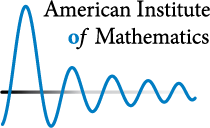2. Other and Related Problems
-
-
Problem 2.1.
[Takagi] Investigate the subadditivity of (Hacon-de Fernex) multiplier ideals in the non-$\Q$-Gorenstein case. -
Problem 2.15.
[Ishii] Define a “test ideal" that relates to the Mather discrepancy multiplier ideal, in the non-$\mathbb{Q}$-Gorenstein case. -
Problem 2.2.
[Patakfalvi] Investigate lifting sections (for cohomology) using test ideals. -
Problem 2.25.
[Mustaţă] Given ideals $I_1, \ldots, I_n$ of a regular, $F$-finite ring $R$, consider the map sending an $r$-tuple of nonnegative real numbers $(\lambda_1, \ldots, \lambda_r)$ to $\tau\left( {I_1}^{\lambda_1} \cdot \ldots \cdot{I_n}^{\lambda_n}\right)$, the mixed test ideal. If we bound all the $\lambda_i$ by some fixed $M$, does there exist a rational polyhedral decomposition such that the function described is constant on the interior of each region? -
Direct summand conjecture
Problem 2.35.
[Hochster] Prove/disprove the Direct Summand Conjecture. -
Answered positively by Huneke-Watanabe at the AIM workshop.
Problem 2.45.
[Schwede] Suppose that $R$ is a local, equidimensional, $F$-pure ring of dimension $d$ with embedding dimension $n$. Is the multiplicity of $R$ at most $\binom{n}{d}$? -
Problem 2.5.
[Lyubeznik] Given a smooth, projective variety $X$ over a number field, does there exist a dense set of primes for which the action of Frobenius on the coherent cohomology $H^i(X_p, \mathcal{O}_{X_p})$ is not nilpotent? -
The 2 $\times$ 2 minors of a generic matrix has been done by Smith and Van den Bergh; try 3 $\times$ 3 minors and higher.
Problem 2.55.
[Singh] Do determinantal rings have finite $F$-representation type? -
Problem 2.6.
[Brenner] For $p \geq 11$, does $\mathbb{F}_p[x,y,z]/(x^2+y^3+z^7)$ have finite $F$-representation type? -
This is known in the Cohen-Macaulay case. An analogous result is known to hold for Du Bois singularities in characteristic zero, in generality.
Problem 2.65.
[Schwede] Suppose that $R$ is a local ring and $f \in R$ is a regular element such that $R/(f)$ is $F$-injective. Does this imply that $R$ is $F$-injective? -
Problem 2.7.
[Blickle] Given a log pair $(X ,\Delta)$, we know that there exists a finite map $\phi: Y \to X$ such that $\operatorname{im}\left(\phi_{*} \mathcal{O}_Y \left( K_Y - \phi^*\left( K_X + \Delta \right)\right) \overset{\text{trace}}{\longrightarrow} \mathcal{O}_X \right) = \tau(X, \Delta)$. Is this statement true if further decorated by $\mathfrak{a}^t$? What about for alterations? -
Problem 2.75.
[Mustaţă] Identify a possible positive characteristic analog of minimal log discrepancy. -
Problem 2.8.
[Schwede/Patakfalvi] Investigate possible Bertini theorems for $F$-singularities. -
Problem 2.85.
[Joshi] Investigate the applications of the topics of the conference (e.g., test ideals) to projective geometry.
Cite this as: AimPL: Test ideals and multiplier ideals, available at http://aimpl.org/testandmultiplierideals.
